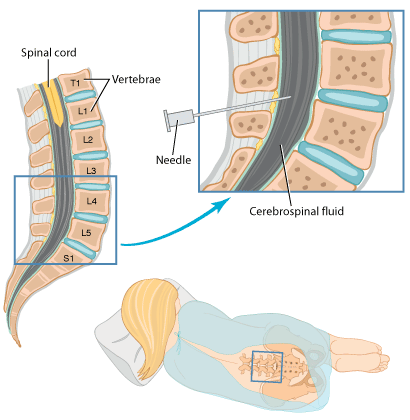Spinal Tap
Article Translations: (Spanish)
What Is a Spinal Tap and Why Do You Need It?
A spinal tap (also called a lumbar puncture) is a medical test that involves taking a small sample of cerebrospinal fluid (CSF) for examination.
Cerebrospinal fluid is a clear, colorless liquid that delivers nutrients to the brain and spinal cord and "cushions" them for protection. In a spinal tap, a doctor carefully inserts a needle between the bones of the lower spine to collect a sample of this fluid. Doctors sometimes use a needle in the same way to put chemotherapy medications into a person's spinal fluid.
Testing the cerebrospinal fluid can help doctors detect or rule out suspected diseases or conditions. CSF tests can help provide information on:
- signs of possible infection (such as meningitis) by analyzing the numbers and types of white blood cells, protein levels, glucose, and bacteria in the fluid
- bleeding in the brain
- conditions affecting the nervous system, such as Guillain Barré syndrome and multiple sclerosis
Preparation
The spinal tap is usually done in a hospital. You don't need to do anything special to prepare for it. Before the procedure, you'll usually change into a hospital gown. The doctor doing the lumbar puncture might ask if you're allergic to any medications.
The Procedure
The entire procedure takes about 30 minutes (most of this is preparation time). Some hospitals let a parent stay with you, if you want.
Doctors will ask you to either lie on your side with your back curved out or sit on an exam table while leaning over with your head on a pillow. This ensures the spaces between the vertebrae are as wide as possible, which makes it easier for the doctor to insert the needle.
The doctor starts by cleaning the back with an antiseptic and injecting liquid anesthetic into the tissues beneath the skin. The anesthetic makes sure you won't feel any pain. Sometimes a doctor, nurse, or technician will put a numbing cream on your skin before the anesthetic is injected.

The needle for taking the fluid sample is thin. The length of the needle depends on the size of the patient. The needle is hollow, and inside the hollow core is a "stylet," another type of thin needle that acts like a plug. After the doctor puts the spinal needle into the lower part of the back, he or she carefully takes out the stylet so the cerebrospinal fluid can drip out into the collection tubes.
While some people notice a brief pinch and some discomfort, most people don't find a spinal tap to be painful.
You'll need to lie still while the fluid sample is being collected. It usually takes about 5 minutes. When it's done, the doctor takes the needle out and puts a small bandage over the area. The sample is sent to a lab for analysis and testing.
Your doctor might ask you to lie on your back for a few hours after the procedure.
Safety
A spinal tap is considered a safe procedure with minimal risks. Most of the time, there are no complications. Occasionally, a patient may get a headache (this is why doctors sometimes ask patients to lie down for a few hours after the test — drinking plenty of fluids may also help prevent headaches).
You may feel tired and have a mild backache the day after the procedure.
As with any such procedure, there is a slight risk of infection or bleeding. In reality, though, that almost never happens.
Results
Some results from a spinal tap are available within 30-60 minutes. However, to look for specific bacteria growing in the sample, a bacterial culture is sent to the lab and these results are usually available in 48 hours. If it seems there might be an infection, the doctor will start antibiotic treatment while waiting for the results of the culture.
Note: All information is for educational purposes only. For specific medical advice, diagnoses, and treatment, consult your doctor.
© 1995-2024 KidsHealth ® All rights reserved. Images provided by iStock, Getty Images, Corbis, Veer, Science Photo Library, Science Source Images, Shutterstock, and Clipart.com

